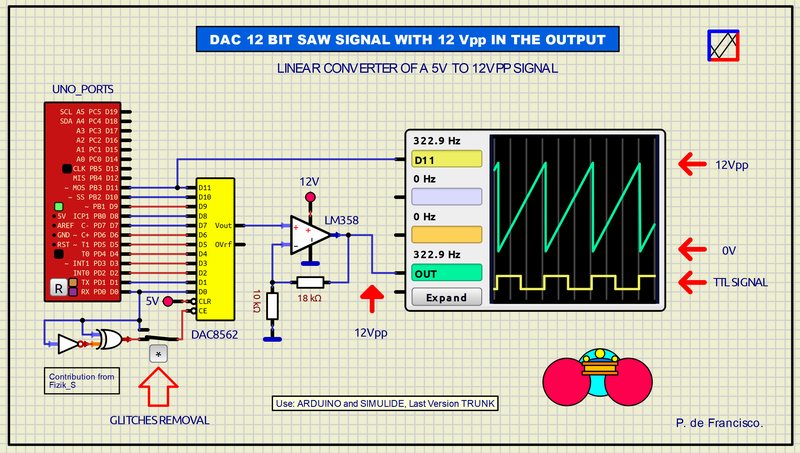327__SINGLE SIGNAL DC AMPLIFIER
Quote from Defran on November 30, 2023, 9:41 am
327_SINGLE SIGNAL DC AMPLIFIER. (Simulide R2116 or higher.)
This example is based on number 71 of the first series. It is intended to make a sawtooth generator by software. Arduino UNO is used with the register programming graph, which is made to optimize controller times. What is included in this version is an amplifier that can boost the DAC output signal from 5V to 12V using the LM358 opamp.
SCHEME:
The DAC8562 12-bit "Digital Analog Converter" DAC connects to pins D0 to D11 of UNO. The CE input uses a logic trick (proposed by Fiszic_S back in the day) to avoid switching glitches, glitches that can be seen if the "GLITCHES REMOVAL" switch is toggled. The output of the DAC is connected to the amplifier that raises the signal level to the power supply value of the LM358 opamp, in this case to 12V. The output is connected to the oscilloscope where you can see all the signals depending on the operation. The yellow channel is connected to D11 to see the highest bit of the DAC which can act as a timing and measurement logic input
PROGRAM:
Arduino C register programming:// DAC 12 BIT RAMP. REGISTERS PROGRAMMING. DEFRAN23 byte H,L; void setup() { DDRD=B11111111; // CONFBG PORT D, DDRB=B00001111; // CONFBG PORT B } void loop() { for (H=0; H<=15; H++) // PORT B, HIGH { PORTB=H; for (L=0; L<255; L++) PORTD=L; // PORT D, LOW } }
SUBCIRCUITS:
This example integrates several subcircuits located in the "data" folder into the ZIP attached. This folder must always be next to the "sim1" scheme so that it can be executed. A subcircuit is a "custom" circuit that accumulates a set of Simulide base components (primitive function) to obtain a new or an adapted function. These subcircuits are treated by Simulide as another component of its own structure. User can create his own subcircuits or use the ones published here in your own designs once the procedure is known, explained in detail in the Simulide tutorials: https://simulide.com/p/subcircuits/
* Communication with the author: Simulide/User/Messages/Defran
P. de Francisco.

327_SINGLE SIGNAL DC AMPLIFIER. (Simulide R2116 or higher.)
This example is based on number 71 of the first series. It is intended to make a sawtooth generator by software. Arduino UNO is used with the register programming graph, which is made to optimize controller times. What is included in this version is an amplifier that can boost the DAC output signal from 5V to 12V using the LM358 opamp.
SCHEME:
The DAC8562 12-bit "Digital Analog Converter" DAC connects to pins D0 to D11 of UNO. The CE input uses a logic trick (proposed by Fiszic_S back in the day) to avoid switching glitches, glitches that can be seen if the "GLITCHES REMOVAL" switch is toggled. The output of the DAC is connected to the amplifier that raises the signal level to the power supply value of the LM358 opamp, in this case to 12V. The output is connected to the oscilloscope where you can see all the signals depending on the operation. The yellow channel is connected to D11 to see the highest bit of the DAC which can act as a timing and measurement logic input
PROGRAM:
// DAC 12 BIT RAMP. REGISTERS PROGRAMMING. DEFRAN23
byte H,L;
void setup()
{
DDRD=B11111111; // CONFBG PORT D,
DDRB=B00001111; // CONFBG PORT B
}
void loop()
{
for (H=0; H<=15; H++) // PORT B, HIGH
{
PORTB=H;
for (L=0; L<255; L++) PORTD=L; // PORT D, LOW
}
}
SUBCIRCUITS:
This example integrates several subcircuits located in the "data" folder into the ZIP attached. This folder must always be next to the "sim1" scheme so that it can be executed. A subcircuit is a "custom" circuit that accumulates a set of Simulide base components (primitive function) to obtain a new or an adapted function. These subcircuits are treated by Simulide as another component of its own structure. User can create his own subcircuits or use the ones published here in your own designs once the procedure is known, explained in detail in the Simulide tutorials: https://simulide.com/p/subcircuits/
* Communication with the author: Simulide/User/Messages/Defran
P. de Francisco.
Uploaded files:
